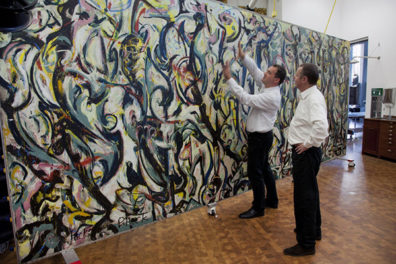
View of Bagan archaeological site, Myanmar. Courtesy of the J. Paul Getty Trust
Bagan, Myanmar, is known for the over 3,500 ancient temples, pagodas, and monasteries that dot its landscape. These magnificent structures house an astonishing array of wall paintings, sculptures, decorations, and inscriptions that are the surviving traces of a powerful empire.
The region, named a UNESCO World Heritage site in July 2019, has been plagued by earthquakes, flooding, and the challenges of increased tourism. While the UNESCO designation will bring welcome attention to the region, increased numbers of visitors will compound the site’s conservation challenges.
To address these issues, the Getty Conservation Institute will begin a long-term commitment in Bagan to conserve and protect ancient cultural heritage, supporting Myanmar’s Department of Archeology and National Museum.
“Bagan is a treasure. This vast cultural landscape is significant not only to the people of Bagan, but to people around the world as evidenced by its recent inscription on the World Heritage List,” said Tim Whalen, John E. and Louise Bryson Director of the Getty Conservation Institute. “We look forward to this long-term partnership with our colleagues here at Bagan to conserve this magical place and together to build the professional capacity necessary to preserve its significance well into the future.”

View of the Sula-mani-gu-hpaya temple in Bagan, Myanmar. Courtesy of the J. Paul Getty Trust
Bagan was the first kingdom to unify the regions that would later become modern-day Myanmar. There is archeological evidence dating back to the 2nd century AD, but the surviving monuments were built during Bagan’s golden period between the 11th and 13th centuries. It remains an important and active place of pilgrimage and worship.
Getty will partner with local officials to address the complex conservation issues and to preserve the site for future generations. Work will include research into the repair of buildings damaged by earthquakes and assistance to prevent damage from future seismic events, and identifying methods and training to conserve the treasured decorative elements of the site.

Detail of wall paintings in the interior of Myin-pya-gu temple, Bagan, Myanmar. Courtesy of the J. Paul Getty Trust
“We really appreciate the efforts and goodwill of the Getty Conservation Institute team to make Bagan more sustainable. We will work together long term for the best protection of cultural heritage in Myanmar,” said U Kyaw Oo Lwin, director general of the Department of Archaeology and National Museum.
The project will include a number of case studies that will be used to inform future conservation efforts in Bagan and elsewhere. One of the first buildings to be studied will be Myin-Pya-Gu, an expansive and picturesque temple that has been closed to the public for several years due to conservation concerns.
One of the goals of the project is that other regions of Southeast Asia will be able to learn from the conservation experience in Bagan.




Comments on this post are now closed.